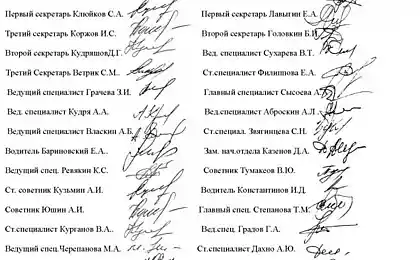805
Battle for Arctic icebreaking superiority of Russia
I regret to have to state the fact that over the past two and a half decades, our country has descended lower and lower on the steps of scientific and technical progress. In some areas, progress was replaced initially by stagnation and then gave way to stagnation and all frank regression. However, despite years of total underfunding and greater concern for political PR and, say, bread and butter, remained the technical segments that are not degraded and kept at an acceptable level. One of those segments is a Russian icebreaker fleet, which today seems the most impressive in the world.
If we talk about the biggest icebreakers that Russia has at the moment, the fleet is as follows:
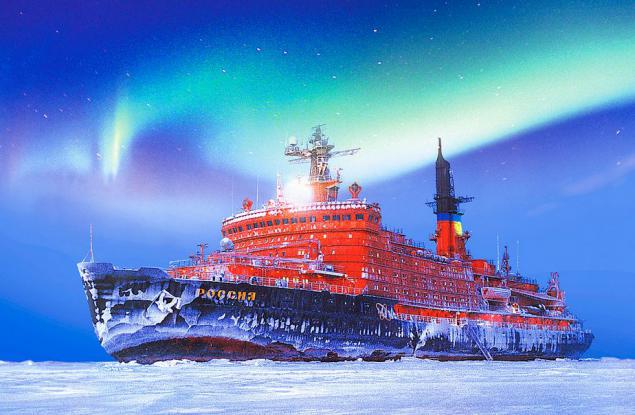
The atomic icebreaker "50 Years of Victory" (Project 10521). It is the largest not only in Russia but also in the world. Overall width of this giant is 30 meters, the maximum length - about 159, 6 meters of sediment - 11 m, capacity on the shafts (energy flows for the propulsion system of the shafts) - 49 MW propulsion power - 54 MW. Displacement - 25168 tons. The maximum thickness of the ice, which is designed to handle the icebreaker is 2 to 8 m. The crew - 106 people (today). Put into operation in 2007, JSC "Baltic Plant" (was laid back in 1989).
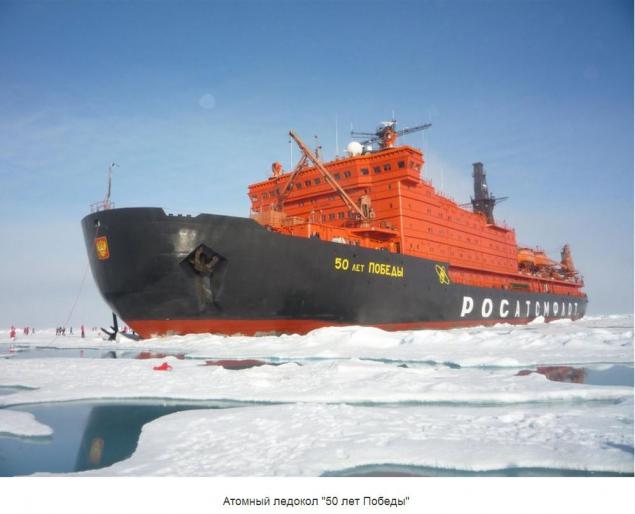
Not much behind the technical parameters of the "50 Years of Victory" atomic icebreaker "Yamal". Launched in 1992 (tab 1986). Length - 148 meters, width - 30 meters, draft - a little more than 11 m. Displacement - 23,000 tons. Propulsion power - 54 MW. Manufacturer - Baltic Plant (St. Petersburg). Designed for maximum thickness of 2 meters. In fact, working in ice up to 2, 7-2, 8 m. The crew - 150 people.
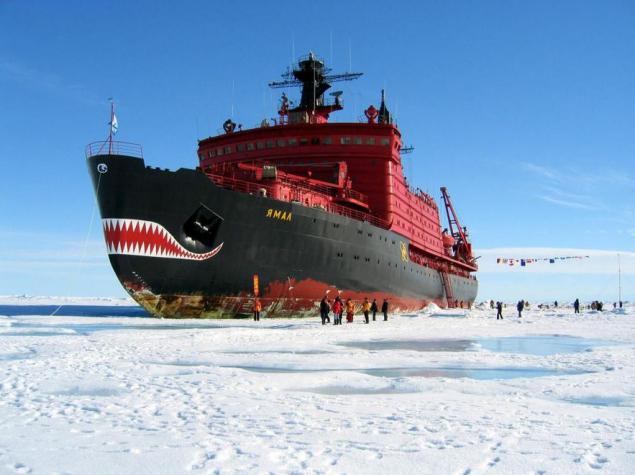
The atomic icebreaker "Taimyr". Main line use - navigation through Siberian rivers (estuaries). I lay in the Soviet era in Finland. The customer, of course, the Soviet Union. Maximum length - 151, 8 m, width - 29 m 2, displacement - 21,000 tons, propulsive power - 35 MW. Draft 8, 1 m. The calculation of the maximum ice thickness - 1, 77 meters.
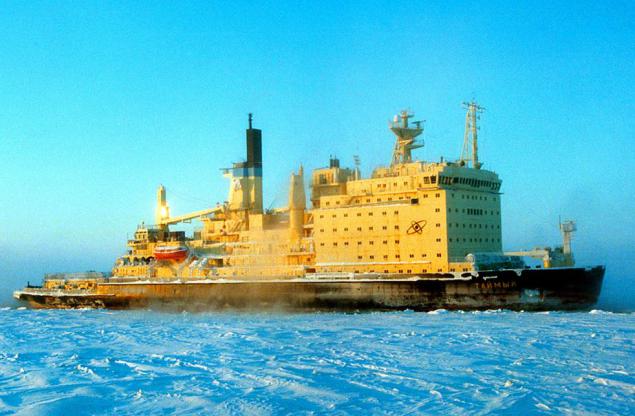
The nuclear icebreaker "Vaigach". It belongs to the same project as the icebreaker "Taimyr" (Project 10580). Bookmark occurred at the same shipyard, which was laid AL "Taimyr", commissioned in 1990 at the Baltic Plant.
Until recently in the Atomflot were more and icebreakers such as the "Soviet Union" (derived from the Navy in 2010) and "Arctic" (derived from the Navy in 2008).
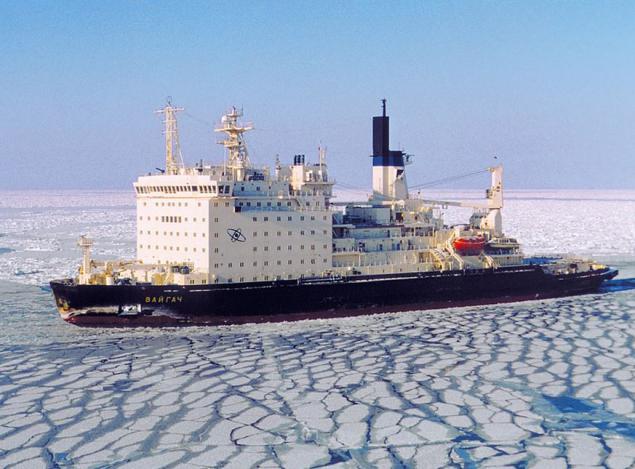
In addition to the nuclear icebreakers their difficult service in the Arctic and Antarctic latitudes are diesel-electric icebreakers, including "St. Petersburg" Project 21900 (Tab 2006, put into operation in 2009), "Moscow" of the same project (commissioned in 2008), "Captain Nikolaev", "Akademik Tryoshnikov" (introduced in 2012), "Ermak" (1974 startup).
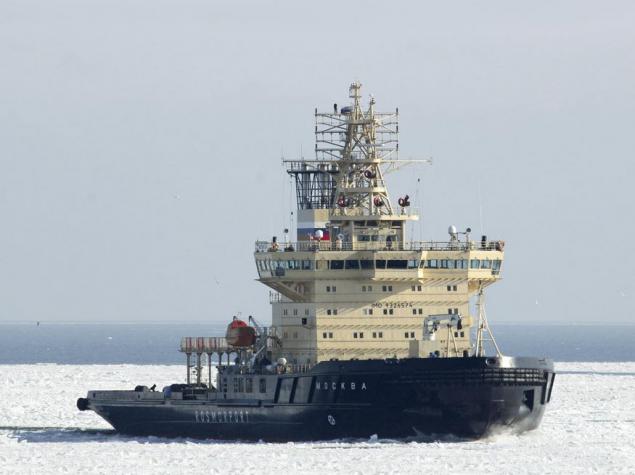
The group seems to be impressive, but to address the challenges that the Russian government today voiced and such groups may not be enough. The main direction of future work - to ensure the full operation of the Northern Sea Route (NSR). To the attractiveness of this area of cargo transportation to foreign countries is not lost relevance in the winter time (and this is the most important task), we need a unique icebreakers that can overcome the ice jams thickness of about 3 to 5 m. It would seem that to solve this problem simply can not afford, but it is gratifying to realize not only that under force, but that problem is solved now.
On all the same Baltic Shipyard (a true cradle of Russian nuclear icebreaker fleet) in January of this year, construction of a new project icebreaker LK-60YA. The value of 60 in the name of the project indicates that the power (on trees) this more than 172-meter colossus is 60 MW (more than the most powerful to date, AL "50 Years of Victory"). Designers and increased width of the ice-breaker - up to 33 meters. This will allow the NSR container ships and other vessels of suitable size - those who today, even if desired, their owners can not go through the NSR - width high. Nuclear reactors designed in the experimental design bureau. Afrikantov representing the company "Rosatom". It is noteworthy that the maximum landing icebreaker LK-60YA the project will be 10, 5 meters - less than in the same AL "50 Years of Victory". This will allow such ships icebreaker leads straight to the mouths of some Siberian rivers. Commissioning of the first icebreaker of the project (all of these will be built AL 3) is scheduled for 2018. He is planning to assign a legendary name "Arctic».
This update group Russian icebreaker stops. The plans - construction of the Arctic monster 200-meter-long and nearly 40 meters wide, with a displacement of more than 55, 5 thous. Tons capacity will be almost twice exceed the capacity of the existing icebreaker "50 Years of Victory". This project LK-110YA. That he would have to turn the Northern Sea Route in the trade route, operating all year round, because it is designed with the expectation of working in ice about 3, 5-3, 6 m thick. The development of the reactor is carried out in the said OKBM im.Afrikantova.
By and large, the Russian nuclear icebreakers in the Arctic, there is a big competition now, but if we have more and more ships of this type with more power, then Russia will be able to speak boldly about the full technical and technological monopolization in the region. In 2008, the US Congress made a statement about the growing influence of the Russian icebreaker fleet in the Arctic. At the same time, it was estimated that the United States in the coming years will need at least 3 billion dollars just on what to start implementing their own project to create a powerful nuclear icebreakers capable of operating in all latitudes of the Arctic. But the idea of new spending in a moment of great crisis somehow not relished most, and its full analogue NSR US does not have, and therefore decided that the Russian "then catch up and overtake." In addition, a small group of members of Congress insisted that the nuclear-powered icebreakers in the Arctic will soon all be superfluous, since there is global warming, melting and everything like that ... It took 5 years - in the United States in terms of implementation of the icebreaking program, little has changed, and in the Arctic winter is still the case for minus 45 and below (on the question of early warming and melting ice-scale) ...
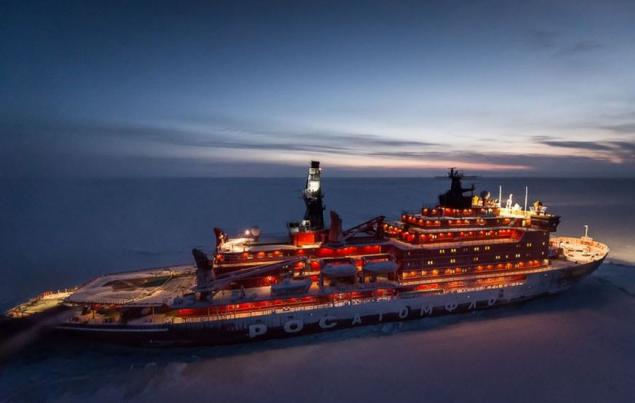
However, the Americans - this is not the only competitor to Russia in the Arctic. Not long ago, the Chinese icebreaker "Snow Dragon", "walk" along the Northern Sea Route, apparently, analyzing the extent to which free trade can be carried out here for the court from China to Europe.
"I Walked" he summer (2012), and summer and winter SMP - is, as they say, two big differences. At the same time, the Internet has become a walking joke about how much the crew of the Russian nuclear-powered icebreaker "50 Years of Victory" will take with the Chinese, when suddenly their "Snow Dragon" will not have time until September or October to depart home ... Joke with a hint of power and the dimensions of the "Dragon »...
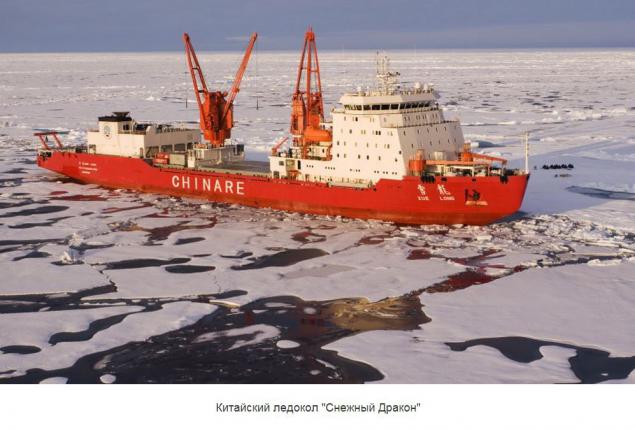
But joking aside, and let them build their own icebreakers not only Chinese. South Korea, too, was among the icebreaking powers by building a few years ago "Araon" length of 110 meters and a displacement of about 7 thousand. Tonnes. Not a giant of course, but it had to be noted that brought Russian trawler "Sparta" (case, however, was not in the Arctic and in the Antarctic, but still) out of ice captivity.
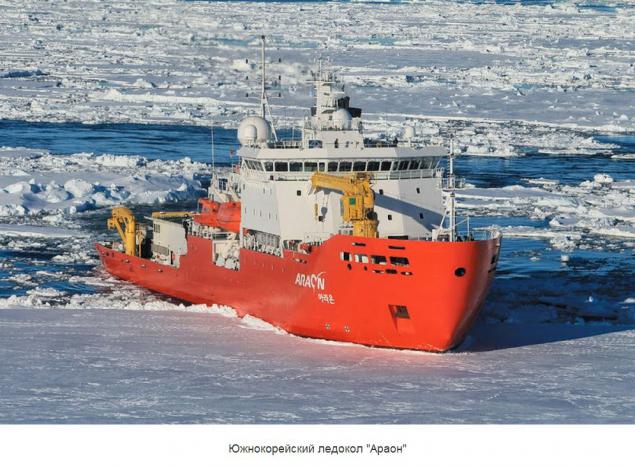
Source:
If we talk about the biggest icebreakers that Russia has at the moment, the fleet is as follows:

The atomic icebreaker "50 Years of Victory" (Project 10521). It is the largest not only in Russia but also in the world. Overall width of this giant is 30 meters, the maximum length - about 159, 6 meters of sediment - 11 m, capacity on the shafts (energy flows for the propulsion system of the shafts) - 49 MW propulsion power - 54 MW. Displacement - 25168 tons. The maximum thickness of the ice, which is designed to handle the icebreaker is 2 to 8 m. The crew - 106 people (today). Put into operation in 2007, JSC "Baltic Plant" (was laid back in 1989).

Not much behind the technical parameters of the "50 Years of Victory" atomic icebreaker "Yamal". Launched in 1992 (tab 1986). Length - 148 meters, width - 30 meters, draft - a little more than 11 m. Displacement - 23,000 tons. Propulsion power - 54 MW. Manufacturer - Baltic Plant (St. Petersburg). Designed for maximum thickness of 2 meters. In fact, working in ice up to 2, 7-2, 8 m. The crew - 150 people.

The atomic icebreaker "Taimyr". Main line use - navigation through Siberian rivers (estuaries). I lay in the Soviet era in Finland. The customer, of course, the Soviet Union. Maximum length - 151, 8 m, width - 29 m 2, displacement - 21,000 tons, propulsive power - 35 MW. Draft 8, 1 m. The calculation of the maximum ice thickness - 1, 77 meters.

The nuclear icebreaker "Vaigach". It belongs to the same project as the icebreaker "Taimyr" (Project 10580). Bookmark occurred at the same shipyard, which was laid AL "Taimyr", commissioned in 1990 at the Baltic Plant.
Until recently in the Atomflot were more and icebreakers such as the "Soviet Union" (derived from the Navy in 2010) and "Arctic" (derived from the Navy in 2008).

In addition to the nuclear icebreakers their difficult service in the Arctic and Antarctic latitudes are diesel-electric icebreakers, including "St. Petersburg" Project 21900 (Tab 2006, put into operation in 2009), "Moscow" of the same project (commissioned in 2008), "Captain Nikolaev", "Akademik Tryoshnikov" (introduced in 2012), "Ermak" (1974 startup).

The group seems to be impressive, but to address the challenges that the Russian government today voiced and such groups may not be enough. The main direction of future work - to ensure the full operation of the Northern Sea Route (NSR). To the attractiveness of this area of cargo transportation to foreign countries is not lost relevance in the winter time (and this is the most important task), we need a unique icebreakers that can overcome the ice jams thickness of about 3 to 5 m. It would seem that to solve this problem simply can not afford, but it is gratifying to realize not only that under force, but that problem is solved now.
On all the same Baltic Shipyard (a true cradle of Russian nuclear icebreaker fleet) in January of this year, construction of a new project icebreaker LK-60YA. The value of 60 in the name of the project indicates that the power (on trees) this more than 172-meter colossus is 60 MW (more than the most powerful to date, AL "50 Years of Victory"). Designers and increased width of the ice-breaker - up to 33 meters. This will allow the NSR container ships and other vessels of suitable size - those who today, even if desired, their owners can not go through the NSR - width high. Nuclear reactors designed in the experimental design bureau. Afrikantov representing the company "Rosatom". It is noteworthy that the maximum landing icebreaker LK-60YA the project will be 10, 5 meters - less than in the same AL "50 Years of Victory". This will allow such ships icebreaker leads straight to the mouths of some Siberian rivers. Commissioning of the first icebreaker of the project (all of these will be built AL 3) is scheduled for 2018. He is planning to assign a legendary name "Arctic».
This update group Russian icebreaker stops. The plans - construction of the Arctic monster 200-meter-long and nearly 40 meters wide, with a displacement of more than 55, 5 thous. Tons capacity will be almost twice exceed the capacity of the existing icebreaker "50 Years of Victory". This project LK-110YA. That he would have to turn the Northern Sea Route in the trade route, operating all year round, because it is designed with the expectation of working in ice about 3, 5-3, 6 m thick. The development of the reactor is carried out in the said OKBM im.Afrikantova.
By and large, the Russian nuclear icebreakers in the Arctic, there is a big competition now, but if we have more and more ships of this type with more power, then Russia will be able to speak boldly about the full technical and technological monopolization in the region. In 2008, the US Congress made a statement about the growing influence of the Russian icebreaker fleet in the Arctic. At the same time, it was estimated that the United States in the coming years will need at least 3 billion dollars just on what to start implementing their own project to create a powerful nuclear icebreakers capable of operating in all latitudes of the Arctic. But the idea of new spending in a moment of great crisis somehow not relished most, and its full analogue NSR US does not have, and therefore decided that the Russian "then catch up and overtake." In addition, a small group of members of Congress insisted that the nuclear-powered icebreakers in the Arctic will soon all be superfluous, since there is global warming, melting and everything like that ... It took 5 years - in the United States in terms of implementation of the icebreaking program, little has changed, and in the Arctic winter is still the case for minus 45 and below (on the question of early warming and melting ice-scale) ...

However, the Americans - this is not the only competitor to Russia in the Arctic. Not long ago, the Chinese icebreaker "Snow Dragon", "walk" along the Northern Sea Route, apparently, analyzing the extent to which free trade can be carried out here for the court from China to Europe.
"I Walked" he summer (2012), and summer and winter SMP - is, as they say, two big differences. At the same time, the Internet has become a walking joke about how much the crew of the Russian nuclear-powered icebreaker "50 Years of Victory" will take with the Chinese, when suddenly their "Snow Dragon" will not have time until September or October to depart home ... Joke with a hint of power and the dimensions of the "Dragon »...

But joking aside, and let them build their own icebreakers not only Chinese. South Korea, too, was among the icebreaking powers by building a few years ago "Araon" length of 110 meters and a displacement of about 7 thousand. Tonnes. Not a giant of course, but it had to be noted that brought Russian trawler "Sparta" (case, however, was not in the Arctic and in the Antarctic, but still) out of ice captivity.

Source:



















